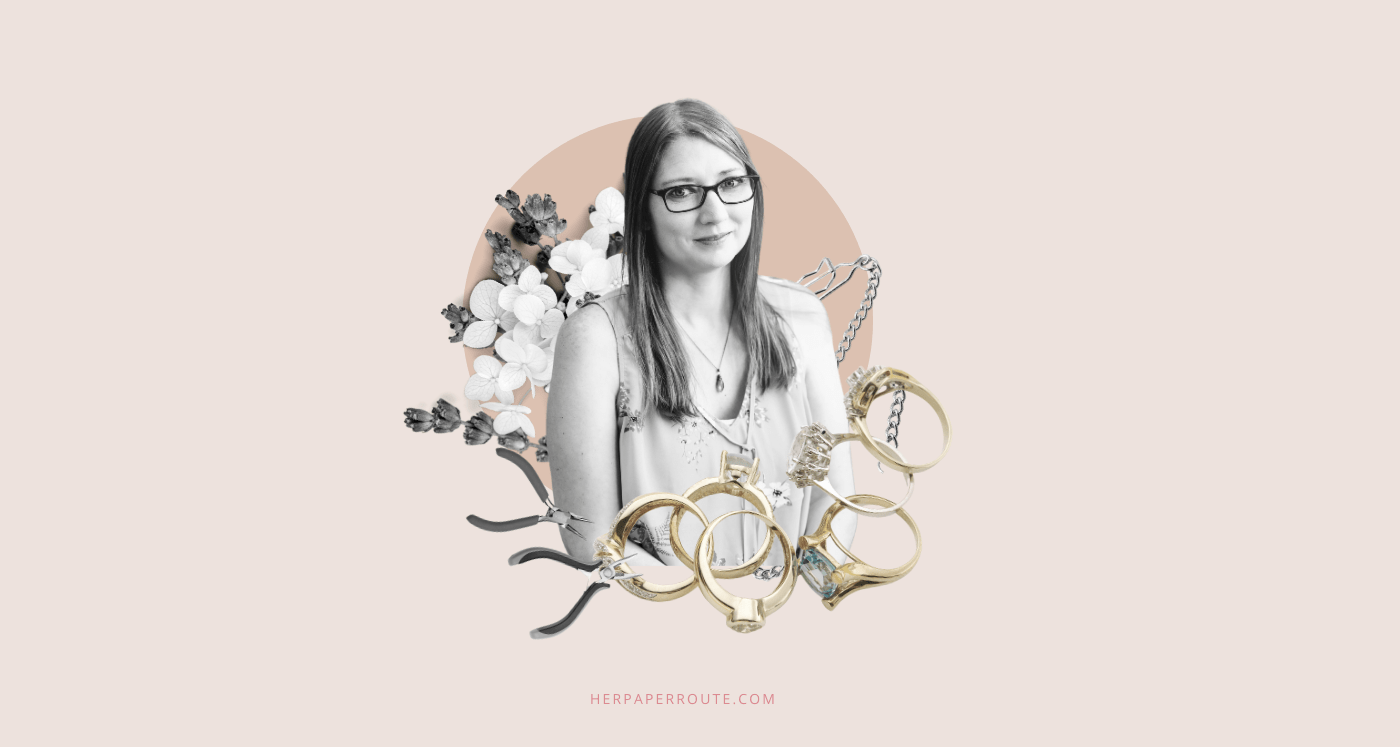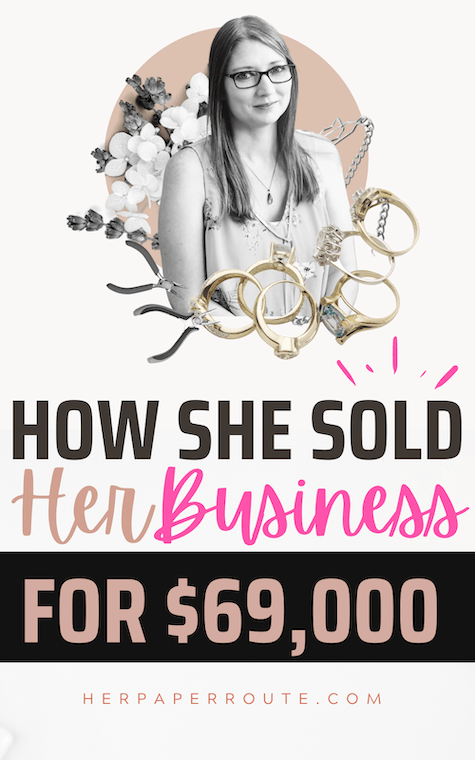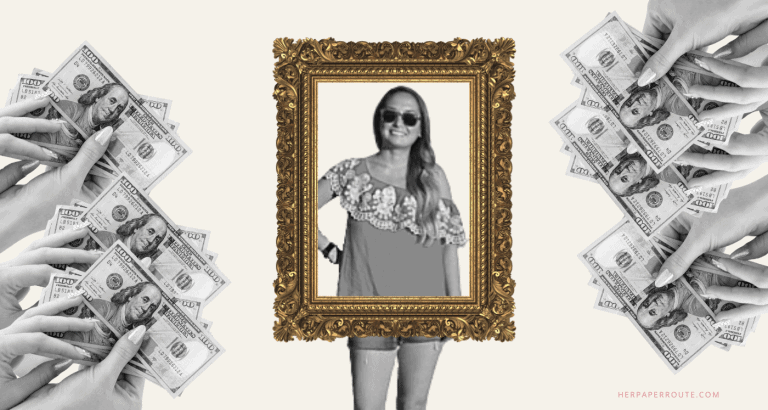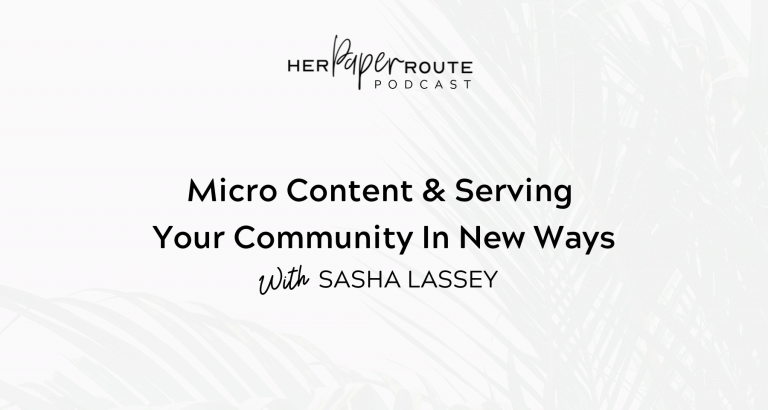How To Sell A Handmade Business For $69,000

How To Sell A Handmade Business: Today on the HerPaperRoute podcast I’m sitting down with multi-passionate entrepreneur Tara Reid.
Last year, I helped Tara sell her Amazon FBA business as her broker, for $69,000 – in the pandemic!
As an affiliate partner of various brands and sponsored content, HerPaperRoute may earn commission on qualifying purchases. Disclaimer
Tara had been feeling burnout in her handmade, physical product business, and wanted to focus on growing another business model – digital products!
She found a positive cure for burnout by selling her handmade business, and by going digital, she could focus on passive income.

She Sold Her Handmade Business For $69,000 To Focus On Digital Products – Shownotes
Here’s Tara’s story of what it was like selling her business, and the insider scoop on what she’s doing now. (Hint: she’s doing A LOT.)
Listen now: How She Sold Her Handmade Jewelry Business For $69,000 In The Pandemic, To Focus On Digital Products.
Listen to the podcast on Apple Podcasts | Google Podcasts | Spotify
Resources mentioned in today’s episode:
- Tara’s Entrepreneur Templates Membership
- Looking to buy or sell a business? Read this.
Tara Reid is a Pinterest manager, the founder of Introvertpreneur, a podcast, Summit + membership for introverted service-providers and entrepreneurs, as well as Entrepreneur Templates, a Canva Templates membership for entrepreneurs who struggle with creating beautiful graphics for their business.
A few months back, Tara was looking to sell her Amazon FBA handmade jewelry business. And she reached out to me to have me to ask me to connect her with a buyer.
I connected her with one of my investors, Tara got a full-price offer and was able to sell her business quickly. She is here on the HerPaperRoute Podcast today to share what that experience was like selling her handmade business, and reveal what she is working on now.
Plus, she is going to share some Pinterest marketing tips to help you boost your Pinterest game, too!
Q. Hey, Tara! Let us know what it is that you do now in your business
Tara: Right now I have three businesses. My main business is marketing Pinterest management services for entrepreneurs. I also do sales funnels, lead magnets and graphic design work.
And then I also have a membership called Introvertpreneur, which is for introverted service providers, and teaching them how to market their business in less stressful ways.
And then I also have a membership.
If you’re managing multiple businesses, you must have some support.
Q. When did you hire on a team? When did you stop being a solopreneur?
I have a team of about 14 now. I hired my first VA about just over a year ago. But what really made the difference was about six or seven months ago, now I actually hired an online business manager.
And that really transformed my business because I felt like with the VA, I was kind of the bottleneck on getting her things to do.
So bringing in a business manager has really helped grow the team and kind of maximize what they’re able to do without me being busy and holding things back.
Q. Yes! And you were running another business up until last year, it was a handmade jewelry business!
Yeah, so I first started my handmade jewelry in 2007. It was a long time that business. It felt like it was my baby almost.
But it grew so big, that I couldn’t keep up with actually making the jewelry.
It got to the point where it was either sell it or I was going to have to hire people and I loved working from home.
I really didn’t want to go that route and have people in my home and I didn’t want to move it out of the home. Because I really love the working from home aspect was a big reason why I started my own business in the first place.
And so I kind of let that business sit for a year before I did finally end up selling it and starting that process. The main reason was that I experienced major burnout and I was hoping I would maybe get my joy back for making jewelry but it never returned.
So I went ahead with the selling process.
Burnout affects so many entrepreneurs. And sometimes, we just need a pivot and a reset and to try something different.
Q. What were some things that you did to prepare your business, and also prepare yourself for letting go of your baby?
It was really hard for me to get to that point because it felt really overwhelming. There are so many pieces of this business, as I’d been building it for so many years.
There was a lot of things to think about when it came to selling. So it was a lot of questioning like, “how, how do I even do this? Like, is it even possible to do this?”
And when I thought about feeling overwhelmed in that way, and then the alternative was just to let it continue to sit and depreciate, that hurt me more than selling it.
I would have hated to see the business just totally die out.
So that was a big deciding factor, which gave me the final push to go ahead with the selling process.
Q. Well, that’s awesome. What did you think when I reached out to you and said, “Hey, Tara I have a full-price offer for you”?
I was so excited. I definitely expected with the higher price point that it would take a while longer to sell than it did. Also, because it was a product-based business, I felt like it would probably take a bit longer to find a buyer.
I was just blown away by the offer. As soon as I connected with the buyer, I saw that she really understood the business and loved and valued it as much as I did when I first created it.
So that was amazing and wonderful.
Q. After you sold, what did you put that money towards? Did you fund your next project?
We actually upgraded our vehicle, and also put some money into my new digital products businesses that I was running!
Related: How to sell digital products from your blog
Q. Now that you’ve run both a physical product store and now a digital one, what are some pros and cons of physical products versus digital?
I feel like the cons are easier to talk about with a product-based business.
There’s the shipping, there’s the making, if you’re making the items, there’s inventory.
That was a big piece of why I experienced burnout with it is because it really exploded on Amazon. And especially during the holiday season.
I could not keep up with orders and that really weighed on me. Amazon gives you an estimate on how much you’ve missed out on sales because products were out of stock and every year.
No matter how early I would start to prepare, it was just like I missed out on $10,000. The next month, I missed out on $20,000.
And I was like “I can’t physically make any more.”
So that really weighed on my mental health and my mindsets. And that was a really good reason why I experienced burnout.
It makes you feel like you’re leaving money on the table, and you should be working harder.
But if you physically can’t make any more like I was, the last Christmas that I was actively making the jewelry and trying to get enough into the warehouses for customer orders.
And trying to keep up, I was probably pretty close to getting carpal tunnel syndrome, because all the jewelry with hand wire wrapped.
So it’s really intricate work. And doing that over and over for 10, 15 hours per day to try to keep up was a lot.
Q. So now that you’re running a digital product business, you’re freed up from having to do any sort of shipping, or physical product creation. Are you finding that it’s become a good source of passive income?
I have definitely! I love so many different models, I’m also working on a few courses to come out this year.
I love creating digital products. And it might be the graphic designer in me. But I really love designing and creating content and putting it out there.
There’s just no limit to digital products! I can create one digital product and sell it 1000 times.
And it’s so much easier than it would have been to create 1000 pieces of jewelry.
Q. Do you have any tips that you could share for digital product creators who might be listening?
For digital products, the most important thing is really understanding your audience, understanding their pain points, and what they really need. And then giving them an option for that.
There are so many different kinds of digital products that you can create, from ebooks, to spreadsheets to templates to swipe files to courses, memberships.
But I feel like a lot of it is tapping into your audience their needs. Do market research to validate your digital product idea.
Q. Great points! What about some tips for handmade sellers who may be listening?
For handmade sellers, I would definitely stress having a game plan for scaling.
Because that’s something that I definitely didn’t do. And is one of the reasons why I kind of got caught in this vicious cycle of trying to keep up with things.
So even if you don’t feel like you’re going to be making $10,000 months or $20,000 months, you should start thinking about what you would need to do if that did happen.
I know there’s been a few people that in the handmade community who have gone viral with a certain product. And then they were totally overwhelmed.
They had no plan on how to accomplish that many orders. So I think just even thinking about that and kind of thinking what you would do in that case and some steps that you would do before it happens would be great.
Also, a lot of handmade sellers aren’t using Pinterest effectively for business. Pinterest is an amazing platform for getting your products out there too. It’s not just for bloggers or digital marketers.
There’s definitely room on Pinterest for e-commerce brands.
Q. What is your Pinterest strategy right now? What are you seeing working on the platform?
There’s definitely been a lot of changes in the past year. It’s been very crazy.
Because as a Pinterest manager, we know that Pinterest really stresses the importance of fresh content. And people were really struggling.
I noticed in a lot of Facebook groups people were asking “what does fresh content mean? How much do I have to create every week and put out there to be successful on Pinterest?”
Because it’s so important to have a lot of fresh content, which just means fresh pin designs.
When they say fresh pins, it doesn’t necessarily mean a different link, it just means a different pin design.
Years back content creators were repinning the same pins over and over. That doesn’t work anymore (and can actually get your account suspended)
Pinterest has updated the AI and the algorithm, where now they can actually scan your image, and can read the text that’s on a design.
And it can determine whether it’s ever been on Pinterest before or if it’s new.
Because of this, putting out a lot of fresh pins is important. And for me, I usually create three to five for each new blog post or each new opt in or whatever I want to promote. I’ll then use that as a testing ground to see if there’s like a certain style that seems to get more engagement and click throughs.
Or there are certain colors that work better. Because that’s another thing a lot of people struggle with on Pinterest. Branding!
Over on Instagram, you want to keep your designs 100% on brand. But that’s not really beneficial for Pinterest, because it’s not like people are going to your profile and looking through at all your pin designs.
They’re finding one pin. And it’s more about that pin’s design and how clickable it is.
Q. So what makes a great, clickable pin?
Make sure you have text on the pin that it’s easily readable. You can try some that have a call to action, some that don’t. And I would just try a bunch of different styles and see what works.
I know even working with clients that are in the exact same niche, it’ll be different between the two.
So I really push testing a lot of pin designs. My Entrepreneur Templates Membership has a lot of Pinterest templates to help you with this. A lot!
That’s a great thing to mention Tara! You are a Pinterest manager, so you’ve tested things and tested different designs with your different clients. You’re able to give that to your membership members and help them to know what to do because you’ve tried and tested it yourself. So that’s great!
Q. If anyone is listening right now who has a handmade or a digital business, and they are thinking of selling, what is some advice that you could offer them?
My best piece of advice would be to reach out to you Chelsea.
I’ve definitely referred a lot of people to you because working with you made the process so much easier for me, with no overwhelm. And any questions I had, you made me feel like the process was easy and smooth.
And I knew exactly what needed to be done and how to do it. So I would definitely, definitely recommend you.
How To Sell A Handmade Business For $69,000, Pivot to Digital Products – Conclusion
Thanks for tuning into the HerPaperRoute Podcast. We hope you found this episode helpful. If you did, please say so by leaving us a review!
To find out how much your business could sell for, get a free valuation.

Follow along on Instagram!












